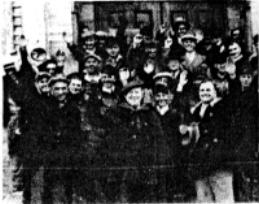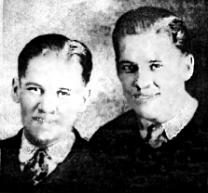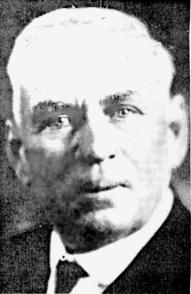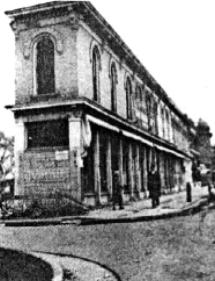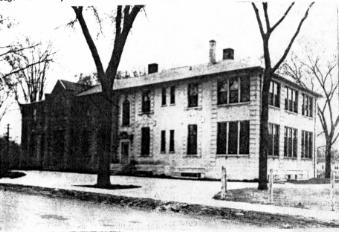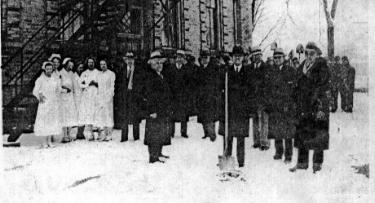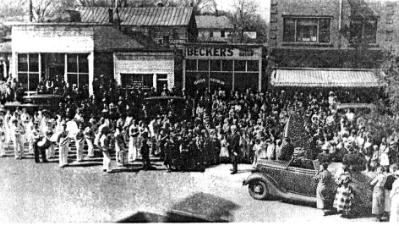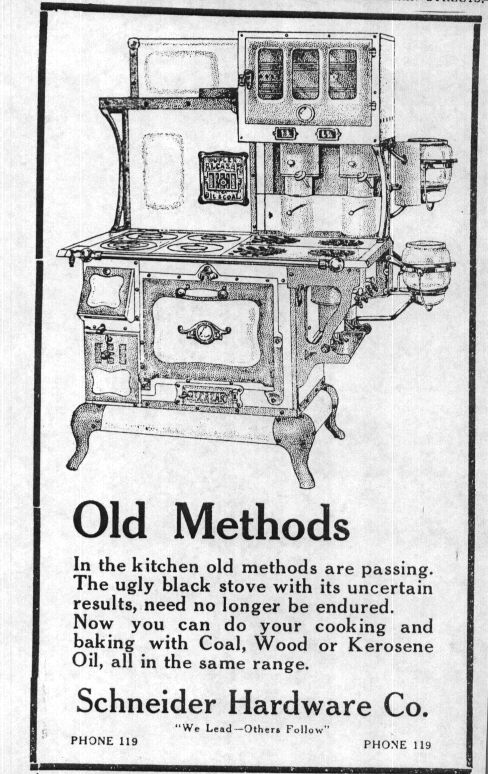Oconto County Reporter
November 11, 1971 - Special Edition Contributed by Dave Cisler
August 1, 1931 OCONTO NATIONAL BANK DOORS ARE CLOSED The party was over. Dreams turned into nightmares as the bottom fell out of the stock market on a day to be remembered as "Black Thursday". A time of bread lines and soup kitchens and shanty towns called "Hoovervilles". John Dillinger and "Baby Face" Nelson robbing the banks. Roosevelt closing them. Postage up to three cents for first-class mail; the Lindbergh baby kidnapped; and King Edward VIII renouncing his throne "to marry the woman I love." These were the headlines of the '30's. It was the decade when prohibition died, Rudy Valee broke a million hearts by marrying Fay Webb, skirts slid down to mid-calf, women suffered for beauty under torturous permanent wave machines, and Walt Disney gave birth to seven dwarfs. In 1930 we went to the Princess theatre to see Gloria Swanson in her first talkie, "The Trespasser", (produced by Joseph P. Kennedy), watched a two-mile relay roller race in the armory, and gathered on Main street to hear the weekly concert of the city band under the baton of Chester Beaudin. Those with radios listened to the homey twang of Will Rogers, chuckled over "Amos and Andy", and wept over the tribulations of "Stella Dallas"; and those without, found entertainment in the novels of Kathleen Norris. * * * To help those out of work, the Reporter, in cooperation with local civic and fraternal organizations, printed free classified ads for those seeking odd jobs. On August 1, 1931, the Oconto National Bank closed its doors, and a week later the Oconto Falls State Bank followed suit in the wake of heavy withdrawals. In September, the Hoover Emergency Committee on Employment took to the radio to urge all young people to stay in schools instead of taking jobs that should go to men with family responsibilities. Still, unemployment grew at a stupefying rate. In 1931, there were 116 families on welfare in the city; by 1935 the figure had grown to 1,334. In a effort at relief, the county cut the total tax valuation by $2.5 million and managed to reduce the tax levy by $70,000 by paring expenses. There was one bright light in an otherwise dark picture
- beer came back. In March 1933, President Roosevelt signed the bill
making the suds legal again, and before the ink was dry, Sig Lingelbach,
then Oconto's brewmaster, started the machinery of the city's brewery.
The blame for the nation's misery was put on the shoulders
of President Herbert Hoover, who had been the wrong man at the wrong time,
and in 1932 a Democratic landslide sent Franklin Delano Roosevelt into
the White House. In a series of Fireside Chats, the new president
promised to "soak the rich" and began creating his alphabetical New Deal
agencies
Although, as noted by W. T. Comstock in a Reporter editorial, the rich paid only two per cent of the cost of the projects and John Q. Public the remainder, the community did receive marked benefits from Mr. Roosevelt's New Deal programs. The CCC alone put hundreds of men to work in forest conservation projects, women were employed sewing clothes for the needy, and several young men found part-time employment by NYA and still others by recreation, music, art and other projects. But it was through he judicious request of funds under the WPA program that the city was to receive the most lasing benefit. Three miles of The city's sanitary sewers, new sidewalks, and a great deal of the curb and gutter installation were performed under WPA. But the two major WPA projects in town were an addition
built on the Oconto County and City hospital, and the turning of a murkily
lit Main street into a "Great White Way". WPA contributed $12,961
for labor on the hospital project and over $5,000 for labor on the street
lighting
The whole town fell out for the dedication of the completed
projects on June 9, 1937. There was an open house tour of the hospital,
a banquet at the Presbyterian church house, and an evening program at the
armory that included a speech by Mayor John B. Chase, community singing,
WPA
Noted a Reporter story: "The increased facilities of the hospital are another result of the efforts of Hugo F. Muehrcke, vice chairman of the hospital board of trustees, who raised the original funds used to purchase the former county building for conversion into a hospital." Other board members included John Spies of Gillett and Grand Urquhart of Oconto. * * *
In the beginning years of the 1930's, Oconto high school had the largest
The stars of the athletic arena were Waldemar and Albin Winther, twin sons of the pastor of Trinity Lutheran church, and their reputation on the basketball court went far beyond the local newspaper. When the Oconto team played against Neenah (and lost) for the state championship, a sportswriter on the staff of the State Journal wrote: the Oconto team is the most popular in the state by a mile. Them two twins, Waldemar and Albin, gave the crowd some of the best dribbling and guarding you ever saw." But the old high school, built in 1894, was doomed to go before the decade ended. Destined to be the last to graduate form its hallowed halls was the class of 1939, which had the further distinction of being the largest graduating class since the free high school was organized in 1881. In August 1939, just as school was to open for a new term, the school was declared unsafe for further occupancy. A meeting of the school board was called by Superintendent Fulton and plans were hastily made to set up temporary quarters for classes. For the next year, high schoolers studied in the Lincoln school, while the younger scholars were taught in the Presbyterian and St. Mark's Episcopal church houses. The manual arts department was moved to the Krueger Box Company, and music classes were held in the Presbyterian gym. Meanwhile the old building was demolished to a story
and a half and to that the addition of wings on the north and south ends
were built. A WPA grant of $51,144 was obtained to add to the city's
cost of $100,000.
Of all the colorful individuals who played a part in the city's long istory, perhaps none deserves more than George "Wingy" Smith - whose career as a law enforcement officer spanned half a century. A man seemingly without fear, Smith was considered dean of all police officers in Wisconsin long before his retirement in 1935. "Wingy" Smith was not only a one-man police force, he was in many respects "the city". He first began "keeping the peace" in 1883 when his principal job was breaking up street fights among lumberjacks, and was elected city marshal in 1907. He got the nickname of "Wing" after losing a hand in a farm accident, but the stump of arm was not a handicap - it was a formidable weapon. The stories that could be told about his exploits are legion. There was, for example, the time when a man brought into the county jail whipped out a pistol and fired two shots at a policeman standing by. When he pointed the gun in his direction, "Wing" sprang at him knocking the weapon from his hand, but not before a bullet creased his trouser leg. The chief then proceeded to knock the prisoner out with the stump of his arm. An even more famous incident occurred down at C&NW depot where the police chief was called after forty or fifty "bums" had dropped off here from a freight train. George soon spotted the leader of the gang and started down the tracks after him. The hobo jumped on the train and drew a revolver, firing point blank into George's face. The bullet struck the chief's clenched teeth, knocking out several, with an impact that knocked him down. The fireman on the train then whacked the tramp over the head with a poker, knocking him off the deck. Back on his feet, George pounced on the hobo and marched him off to jail. On the way, he coughed up the bullet which had lodged in his throat. "The city expects protection from old George, and gets it," the Reporter noted in 1939, when Smith was in his 46th year of law enforcement. Chief Smith regarded sleep as an unnecessary evil and was on the street from early morning until well past midnight. And, when the city was locked in by a blizzard, the only figure seen stirring was George, out at the crack of dawn with a plow, trying to clear Main street. In the last few years before his retirement, George gave up police work and became street commissioner. Reporter Datelines
MARCH 1930 - Aldermen and the mayor are to receive compensation for their time at meetings - $5 and $2. APRIL 24, 1930 - Hard pressed by Adam Marek, H.F. Muehrcke won the city trap shooting championship in an exciting meet which opened the season of the local gun club at their new grounds Sunday afternoon. JULY 1930 - The death knell was sounded for horse-drawn
fire department equipment in the city as the result of council action to
purchase a motor equipped fire pumper to replace the present auxiliary
horse-drawn equipment. The police department will have a side car
motorcycle, it
AUGUST 1930 - The county has purchased the old Montana Tractor Company building as a highway machine shop and storage shed. OCOTOBER 9, 1930 - Armed bandits held up the
State
Bank of Oconto Falls shortly before noon today and escaped with $5,000
in sliver and paper money. Two men, with overcoat collars turned
up to conceal the lower parts of their unmasked faces, entered the bank
at 10:15. "Stick 'em up!" was the command. All of the employees
and City Clerk Meta Wagner, the only customer present, were then forced
to lie face down on the floor outside of the cages. One bandit watched
them with a drawn revolver while the second scooped up the money.
Ernest Schaal, assistant cashier, was forced to open the safe. The
bandits then hurried out the door to the get-away car and jumped on the
running board, racing north out of Oconto Falls.
FEBRUARY 26, 1931 - Federal prohibition agents early Saturday morning captured one of the largest distilleries ever found in this part of Wisconsin on a farm near Mountain. The still, said to be worth $80,000, was located on a former dairy farm just off highway 32. Captured were 55,000 gallons of mash and 150 gallons of finished alcohol. The still is said to have been run by Chicago operators. Drivers hauling the liquor away are said to have had mounted guns on their trucks. APRIL 23, 1931 - Work on paving the gap in highway 41 began Monday near the Richard House and has already reached Van Dyke street. The five-mile stretch will be finished in four weeks. * * * Englebert Schumacher, who for 31 years conducted the
Schumacher meat and grocery store on West Main street, is to retire from
business. His first place was on Collins avenue. As a youth
he gained a reputation as an expert notcher in log buildings. His
son, Andrew, will take over the
JUNE 4, 1931 - Oconto residents have no desire to be
rudely awakened from slumber by the prolonged whistling of early morning
passenger trains, it was revealed in a petition read to the city council.
It was contended that trains toot their whistles excessively until it becomes
a
JUNE 4, 1931 - A few of the seeds planted last weekend
in the Kiwanis Cooperative garden project have already pushed their heads
through the ground and every day a group of boys may be seen working the
plots. The land is located north of the Sylvester nursery between
Cook avenue and
OCTOBER 31, 1931 - The Green Bay Packers have marked
their 21st consecutive win on their home field.
NOVEMBER 31, 1931 - Cheering news was received today from W. A. Holt, president of the Holt Lumber Company. The sawmill will resume operation here December 1. The entire local crew will be employed on a six-day basis, working six hours daily. Camp No. 5, about eight miles west of Townsend, is the only logging camp in operation. DECEMBER 10, 1931 - Oconto is to be put "on the air" Monday in a special 30-minute broadcast over WLS-Chicago. The greeting to Oconto is through the courtesy of Swift & Company, who will spotlight this community on "Midday Melodies". * * * Payment of a 10 per cent dividend to creditors of the closed Oconto National Bank has been authorized by the insolvent bank division in Washington, D.C. "SECRET SIX" ARRESTED JANUARY 7, 1932 - Confessions of seven youths, ranging in age from 15 to 19, this week cleared up a series of burglaries which have been puzzling local police for several months. The amazing story of these youths, banded into what was know as the "Secret Six", finally came out in the confession of the youngest of the group when brought before the county judge Tuesday. JANUARY 21, 1931 - Mayor Carl Riggins' economy program
was introduced at a special council session held Tuesday. The chief
proposition is to reduce wards in the city from ten to five, thereby saving
$600 in election expense. Other recommendations include permanent
registration of voters, and ten per cent salary slashes for teachers, library
employees, and public officials. The board of education has also
been asked to consider eliminating physical education, home economics and
manual arts and to reduce the music program.
MARCH 3, 1932 - A mile-long swamp in northern Oconto county is believed to have swallowed the big meteor which traced a streak of flame across the sky in northeast Wisconsin February 22. Search for the meteor, one of the largest to fall in Wisconsin from witnesses seeing its descent, was abandoned this week. CITY MAY HAVE NATURAL PARK MARCH 17, 1932 - McDonald's Point, a 45-acre wooded tract across the river from Brazeau avenue, may be converted into a beautiful public park if the ambition of W.A. Holt is realized. Roland E. Stoelting, former Ocontoaon, and an engineer in charge of Milwaukee's park system , has said: "That is one of the most beautiful locations I have ever seen for a park." As Mr. Holt outlined his plans, he would present it to the city with the possibility of using local labor in its preparation and pay the workers out of the poor relief fund sent from Madison. JUNE 2, 1932 - Work on highway 141 in Oconto county will be started this week. Charles Lucia, who will do the grading, is moving equipment to Stiles today. OCTOBER 1932 - W. A. Holt has given $1,000 to relief
work in the development of Holtwood Park.
|

